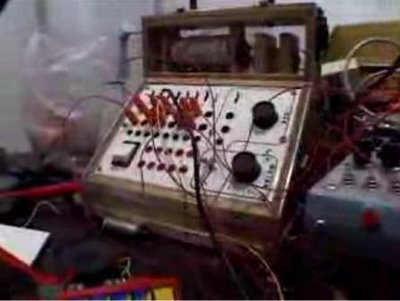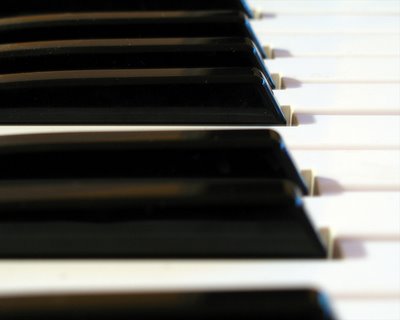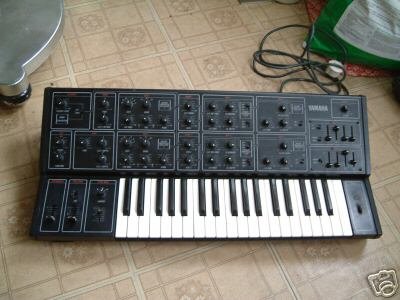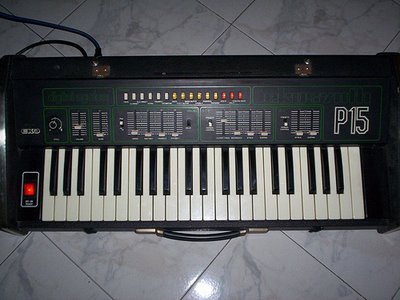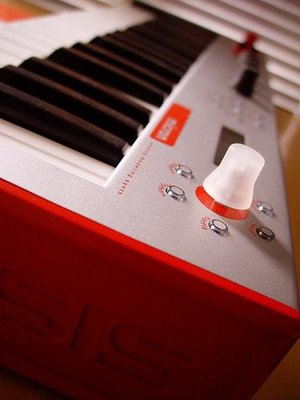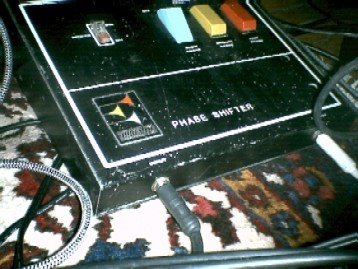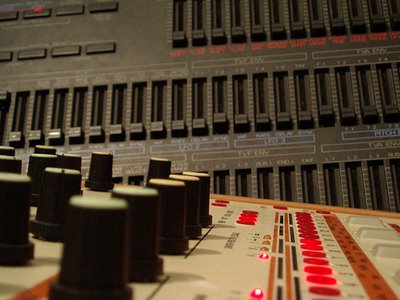 Title link takes you to Mark's thoughts on the Moogerfooger MF-104. He touches on the differences between analog and digital delays and he has very nice sample of the MF-104. If you ever wondered what an MF-104 sounded like, let alone what an analog delay sounded like, check it out. What's great about the demo is that it shows a wider range than typical demos. There is also a timeline on the page so you can read what's happening as you listen.
Title link takes you to Mark's thoughts on the Moogerfooger MF-104. He touches on the differences between analog and digital delays and he has very nice sample of the MF-104. If you ever wondered what an MF-104 sounded like, let alone what an analog delay sounded like, check it out. What's great about the demo is that it shows a wider range than typical demos. There is also a timeline on the page so you can read what's happening as you listen.
Saturday, April 15, 2006
Mark Pulver on the Moog MF-104 Analog Delay Pedal
 Title link takes you to Mark's thoughts on the Moogerfooger MF-104. He touches on the differences between analog and digital delays and he has very nice sample of the MF-104. If you ever wondered what an MF-104 sounded like, let alone what an analog delay sounded like, check it out. What's great about the demo is that it shows a wider range than typical demos. There is also a timeline on the page so you can read what's happening as you listen.
Title link takes you to Mark's thoughts on the Moogerfooger MF-104. He touches on the differences between analog and digital delays and he has very nice sample of the MF-104. If you ever wondered what an MF-104 sounded like, let alone what an analog delay sounded like, check it out. What's great about the demo is that it shows a wider range than typical demos. There is also a timeline on the page so you can read what's happening as you listen.
FM-800 - Korg Poly-800 and EX-800 Filter Mod
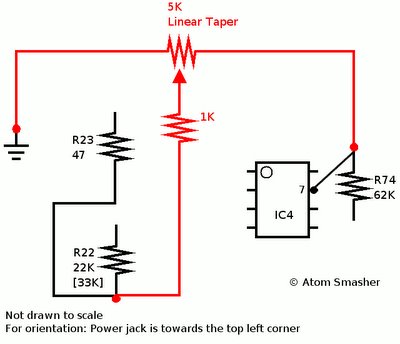 "This modification to the Poly-800 series of synthesizers adds the ability to control Filter Cutoff with DCO1. This is commonly known as FM control of a filter. Although it's technically not Frequency Modulation, the results are capable of sounding very much like an FM synthesizer. A knob allows the effect to be turned from completely off, to far beyond the normal capabilities of a Poly-800. This modification very nicely compliments the Moog Slayer modification for a total of 3 knobs full of fun."
"This modification to the Poly-800 series of synthesizers adds the ability to control Filter Cutoff with DCO1. This is commonly known as FM control of a filter. Although it's technically not Frequency Modulation, the results are capable of sounding very much like an FM synthesizer. A knob allows the effect to be turned from completely off, to far beyond the normal capabilities of a Poly-800. This modification very nicely compliments the Moog Slayer modification for a total of 3 knobs full of fun."Title link takes you there. Don't miss the sample link on top when you get there.
FM800 filter mod
Friday, April 14, 2006
Casper Electronics Orchestra Conductor on YouTube
Cynthia Breaks Down Vactrols on YouTube
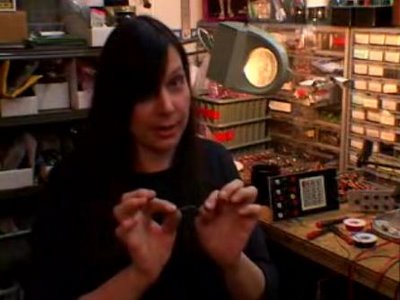 Modular synth maker Cynthia of Cyndustries and the acclaimed Zeroscillator, talks about Vactrols. Title link takes you there. Via Jay. Thank you Jay.
Modular synth maker Cynthia of Cyndustries and the acclaimed Zeroscillator, talks about Vactrols. Title link takes you there. Via Jay. Thank you Jay.
Das Subharchord
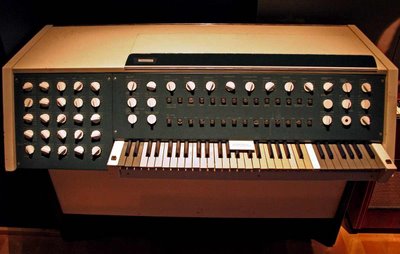
via Das Subharchord
"The Subharchord is a unique electronic instrument which is somewhat comparable to the Mixturtrautonium from Oskar Sala. This site is dedicated to the Subharmonic Sound Generator, which was developed during the 1960s in East Berlin (GDR) at the Radio and Television Technical-Centre (RFZ) of the German post office."
The Mixturtrautonium.

You can find a VST emulation and more info on Rick Jelliffe's site.
More on 120 Years and wikipedia.
Via this this electro-music thread.
The Unique DBK

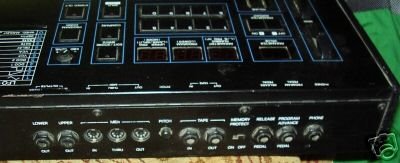
Two shot's via this auction. Title link takes you to the post on VSE where I found this. Some interesting bits (pun intended) from Micke in the post (that Micke knows his synths):
"It's a rebadged LEM Bit 99:
http://www.synrise.de/history/advertises/advert_005.jpg
...which itself is a rebadged Crumar BIT 99.
some insider info:
LEM is/was a subsidiary of General Electro Music, Italy (more known as GEM) and I'm pretty sure they bought the rights from Crumar to re-release the BIT 99 (under the LEM brand) when the Crumar company ceased to exist around the mid-to-late '80's.
Around the same time as this, Gem would buy the ELKA company (another well-known Italian manufacturer of musical instruments) which was owned by the other Crucianelli brother, namely Piero Crucianelli.
(Piero was brother to Mario Crucianelli who owned Crumar). "
A Little Disney History
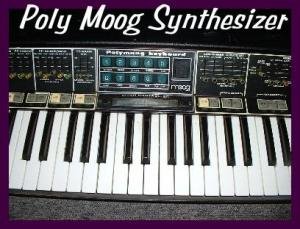 Title link takes you to a post on Craigslist for the Moog Polymoog used in the Disneyland Electric Light Parade. Kind of interesting to me in that I grew up in Hollywood and used to go to Disneyland all the time. I remember pulling an all nighter there with all the goths during one of their special events (I looked the part, but I never was a goth!). : ) I actually had a black crow try to pick one of my hairs thinking it was branch. Another story for another time. I forget what the event was for, but I do remember passing out on a bench and having a great time. What's odd is I've probably heard this exact synth serveral times. This one via Brian Comnes. Thanks for the flashback Brian! : )
Title link takes you to a post on Craigslist for the Moog Polymoog used in the Disneyland Electric Light Parade. Kind of interesting to me in that I grew up in Hollywood and used to go to Disneyland all the time. I remember pulling an all nighter there with all the goths during one of their special events (I looked the part, but I never was a goth!). : ) I actually had a black crow try to pick one of my hairs thinking it was branch. Another story for another time. I forget what the event was for, but I do remember passing out on a bench and having a great time. What's odd is I've probably heard this exact synth serveral times. This one via Brian Comnes. Thanks for the flashback Brian! : )
Two Notrons, a Serge and a Fenix Modular...
walk into a bar, and...
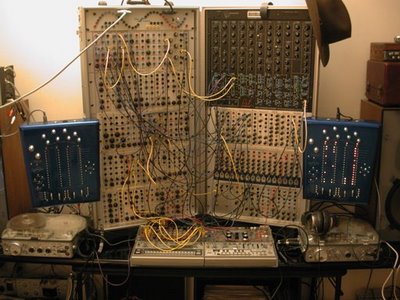
meet a couple o' little TB ladies. The Serge says, "see, hear, and feel the power of my wave (on top)" The Fenix says "I filter the crap out of your wave." The Notrons? "Shut up and dance, slaves. Mr. Tape recorder, start rollin."
Shot sent my way via mrcarp. Click on the shot for its full glory. Thanks Mr. Carp!

meet a couple o' little TB ladies. The Serge says, "see, hear, and feel the power of my wave (on top)" The Fenix says "I filter the crap out of your wave." The Notrons? "Shut up and dance, slaves. Mr. Tape recorder, start rollin."
Shot sent my way via mrcarp. Click on the shot for its full glory. Thanks Mr. Carp!
Thursday, April 13, 2006
Siliconsequences on YouTube
Published on Mar 4, 2006 morbius001
"This is a video demo of the Synthesizers.com Q-960/Q-962/Q-963 ability to be "played" on-the-fly, including skip, reset, stage input/output triggers (C)2005-Cybertron Productions. For more info, join our "synthesizers.com user's group" on Yahoo. Also, check out our WIKI pages
For more info,video demos, and music excerpts by Cybertron."
Ebay Synth Tracking Blog?
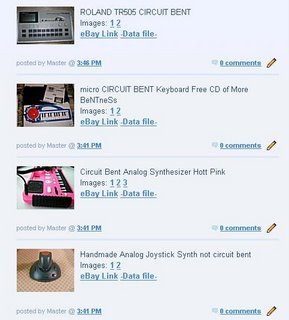 Title link takes you to a Circuit Bent Item tracker for Ebay set up by Circuit Master of GetLoFi. The cool thing about it is that it saves off the media (images and samples) to his server. These are then permanently accessible via the blog posts. I asked him how difficult it would be to set up a synth version. As expected it would not be difficult at all - he just finished a prototype. What do you think? Personally I think it's a great idea for a number of reasons. One it saves the most interesting bits for posterity, two it's kind of cool having a repository for everything synth on Ebay, and three it brings the items to you, making it easier to track what's coming up. On the bad side? Well, for those rare occasions where you might be lucky enough to be the only person to catch a good deal... Well those days would probably be over. The tool would post any item with the word "synth" on Ebay. Please feel free to post your comments. Great idea, sucks, or who cares... Sorry Doktor Future. : )
Title link takes you to a Circuit Bent Item tracker for Ebay set up by Circuit Master of GetLoFi. The cool thing about it is that it saves off the media (images and samples) to his server. These are then permanently accessible via the blog posts. I asked him how difficult it would be to set up a synth version. As expected it would not be difficult at all - he just finished a prototype. What do you think? Personally I think it's a great idea for a number of reasons. One it saves the most interesting bits for posterity, two it's kind of cool having a repository for everything synth on Ebay, and three it brings the items to you, making it easier to track what's coming up. On the bad side? Well, for those rare occasions where you might be lucky enough to be the only person to catch a good deal... Well those days would probably be over. The tool would post any item with the word "synth" on Ebay. Please feel free to post your comments. Great idea, sucks, or who cares... Sorry Doktor Future. : )
EML Poly-Box Samples and the SynthCluster
 Click here for a couple of samples of the EML Poly-Box by George Mattson. Check out his monster setup (click the image for a much bigger shot). That is one massive EML Sequencer. You can see the orange EML Poly-Box below and the EML 101 to the left. Also check out George's site for more.
Click here for a couple of samples of the EML Poly-Box by George Mattson. Check out his monster setup (click the image for a much bigger shot). That is one massive EML Sequencer. You can see the orange EML Poly-Box below and the EML 101 to the left. Also check out George's site for more.Update: Notes from George:
"They're all EML, The sequencer is running on it's own, the Polybox is following an oscillator on the 101 and the 500 is doing the bass line. The drums are actually a real Pearl acoustic set on Power Dive being played by a guy named Pete Gerdin. The vibraphone sound at the beginning of Happy Tune was the vibratone setting on a Yamaha YC-45D combo Organ. The sequencer just gets programmed and turned loose. I just played along with it."
"the samples were 29 years old and dug up off an old cassette in order to let people hear what a Polybox could be used for besides chords. Remember, the BIG music happening then was Disco. (ugh)"
The Button Box
 Title link takes you to the post on the Music Hardware blog with video including a performance and how it works by Evan Morris. What's interesting is in the end of the video he mentions a couple of links but shows links to the MIDIBox website, uCAapps.de. Wonder what the affiliation is...
Title link takes you to the post on the Music Hardware blog with video including a performance and how it works by Evan Morris. What's interesting is in the end of the video he mentions a couple of links but shows links to the MIDIBox website, uCAapps.de. Wonder what the affiliation is..."homebuilt midi controller from artist Evan Morris. The box is a button based wave sequencing system that chops and loops audio files in real time using a Reaktor Ensemble."
Crazy Analog
Title link takes you to Crazy Analog, a S. Korean dealer site with loads of gear shots. This one came in via Ken MacBeth, of MacBeth Studio Systems. BTW, if you are on the hunt for a brand new boxed M3X, at a discount, these guys have a few.
They didn't have a nice shot of the M3X, so here's a Moog Source from them instead.
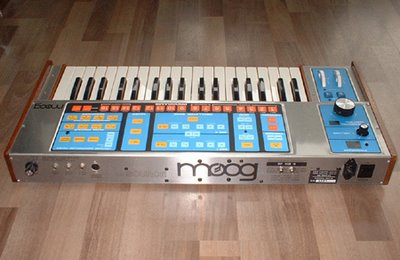
Via Ken MacBeth on AH:
"Hi All! Many people on this list have asked me or made enquiries regarding the availability of the M3X synth that I used to build- I met my S.Korean dealer, Lee, in Frankfurt- to my surprise, he told me that there are 11 available from midistation in S.Korea and a very good price- they were $2200.00USD- but now Lee has dropped his price to $1450.00USD which is a great deal for those who want a brand new, boxed (un-opened) M3X- these one's are special too- featuring blue led's instead of the orange ones! Crikey- remember when blue leds were in fashion!!"
They didn't have a nice shot of the M3X, so here's a Moog Source from them instead.

Via Ken MacBeth on AH:
"Hi All! Many people on this list have asked me or made enquiries regarding the availability of the M3X synth that I used to build- I met my S.Korean dealer, Lee, in Frankfurt- to my surprise, he told me that there are 11 available from midistation in S.Korea and a very good price- they were $2200.00USD- but now Lee has dropped his price to $1450.00USD which is a great deal for those who want a brand new, boxed (un-opened) M3X- these one's are special too- featuring blue led's instead of the orange ones! Crikey- remember when blue leds were in fashion!!"
OHM+ The Early Gurus of Electronic Music

Reed posted a link to this in the comments section of this post on Laurie Spiegal. You can can order it from The Relaxation Company, or if you prefer Amazon, click here.
"Special Edition 3CD + DVD
New Collector's edition of this historic collection!
Leaps in technology: oscillators, generators, vacuum tubes, amplifiers, transistors, magnetic tape, integrated circuits, and the microchip—inspired new instruments: the telharmonium, theremin, ondes martenot,electronic sackbut, clavivox, electronium, moog synthesizer, and computers—and artists everywhere hungry for new modes of expression.
This collection is a humble but bold attempt to give form to the wonderful, multi-directional, inevitable birth of electronic music.
Three CDs—42 original music tracks from 1948–1980
112 Page Book—extensive artist interviews, commentaries, and archival photographs
Special Edition DVD—over two hours of rare performances, interviews,animations, and experimental video."
LABELS/MORE:
Electronium,
MOOG,
Musique Concrete,
Ondes Martenot,
Sackbut,
Synth Books,
theremin,
Video
Wednesday, April 12, 2006
Monome
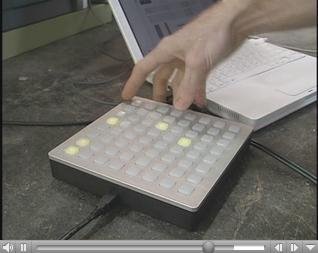 Cool button based MIDI device. Title link takes you to the Monome site with video. Via Analog Industries.
Cool button based MIDI device. Title link takes you to the Monome site with video. Via Analog Industries.
Suzanne Ciani
 This one sent in via Tony Saunders. Title link takes you to the Early Suzanne Ciani webpage with video clips including Buchla. Make sure to track back to the root of the site for more on Suzanne Ciani and don't miss this page on Buchla. Thanks Tony!
This one sent in via Tony Saunders. Title link takes you to the Early Suzanne Ciani webpage with video clips including Buchla. Make sure to track back to the root of the site for more on Suzanne Ciani and don't miss this page on Buchla. Thanks Tony!Update: John Simmons was checking out the site and found this gem. It's a video of Suzanne Ciani creating the sound for the pinball game Xenon. Note the Xenon was released in 1979 according to this site. You can see the NED Synclavier used to sample the sounds in the video and then the guy inserting the chips with the samples in the pinball machine. Pretty cool. Thanks John!
EMS Soundbeam
 Title link takes you to a video of the EMS Soundbeam from this auction. Via Sandro. Thanks Sandro!
Title link takes you to a video of the EMS Soundbeam from this auction. Via Sandro. Thanks Sandro!
Laurie Spiegel and the Bell Labs Programmable Digital Synthesizer
YouTube Uploaded by MusicMouse on Jan 26, 2007
Audio on left channel only.
"Concerto for Self-Accompanying Digital Synthesizer. The instrument is possibly the first realtime digital synthesizer, built at Bell Telephone Labs, NJ by Hal Alles and team, with C language software written by Laurie that processes the player's live input into an ongoing accompaniment that will continue to be played live against.
This is a legal copy uploaded by the owner of the original tape. The OHM DVD's video was taken from this.
For more info on see http://retiary.org/ls/obsolete_systems
For tech info on the synth see:
http://www.matrixsynth.com/blog/media/misc/spiegel/Alles1.pdf"
Laurie Spiegel's website: http://retiary.org/ls/.
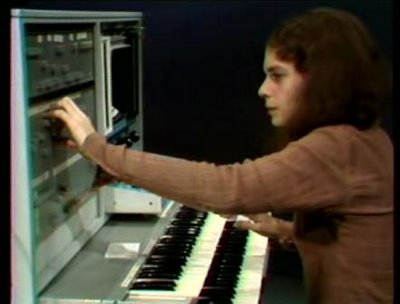 Laurie on Wikipedia
Laurie on WikipediaUpdate embeddable video and description above sent my way via Laurie Spiegel, and via Reed in the comments before the embed: "She's playing a digital synthesizer built by Hal Alles of Bell Labs. Somehow it found its way to Oberlin College in Ohio, where it has remained broken & unused in the basement for over 20 years. (The video, btw, is from the new Ohm DVD compilation). "
Update via Andrew Dean on AH:
"Here's the credit for the Spiegel trackl on the DVD:
Track 12: Laurie Spiegel Improvisation on a 'Concerto Generator'
(2:40) Music, Performance, and Interactive software by Laurie Spiegel,
1977
So, "Concerto Generator" it is. Probably early digital by Hal Alles."
Update: PDF on the instrument. Via ivan on AH.
Update: And more from steve sloan on AH.
Update via Loscha: You can find the patent for Laurie Spiegel's machine here.
Early Kraftwerk on YouTube

The first four via John Neilson on AH (The Robots thrown in for good measure).
autobahn mini documentary
Ruckzuck 1970 as Organization
Tanzmusik 1973
Ruckzuck(2) 1970 as Organization
The Robots
Title link takes you to all 112 results containing Kraftwerk on YouTube.
Jen SX 1000 - New Flickr Shots
flickr by jumpstart. Title link takes you to more.
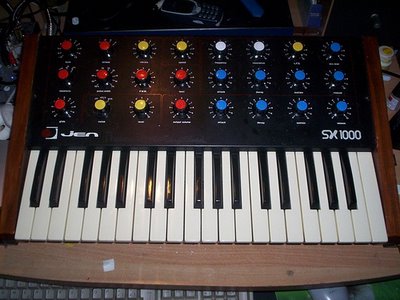
Update: jumpstart posted a link to his blog in the comments: http://benthack.blogspot.com/. Check it out for more. I also added it to my blog roll on the right.

Update: jumpstart posted a link to his blog in the comments: http://benthack.blogspot.com/. Check it out for more. I also added it to my blog roll on the right.
Liquid Bridge and the SpongeRoom
 Title link takes you to the SpongeRoom, a blog for Liquid Bridge. There are tons of gear shots on both sites and there are mp3s on Liquid Bridge.
Title link takes you to the SpongeRoom, a blog for Liquid Bridge. There are tons of gear shots on both sites and there are mp3s on Liquid Bridge.
It was the 80s - New Flickr Set
flickr by tombola2004. Title link takes you to more.
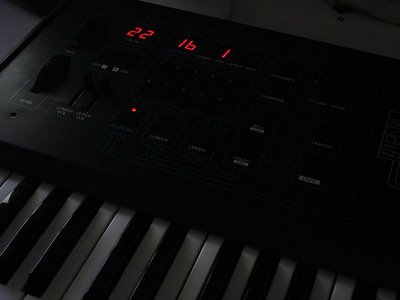
Crumar Bit One
Update via the comments: Turns out this is Tom's of Music Thing.

Crumar Bit One
Update via the comments: Turns out this is Tom's of Music Thing.
Satan's Sermon on Curved Air
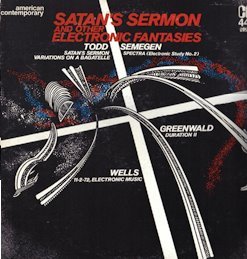 Remember American Contemporary? Curved-Air sent me another, Satan's Sermon. This downloadable album features the Buchla 200, Buchla 500 and the Nova 1200 Data Computer. Title link takes you more including a link to the download (just follow the free links).
Remember American Contemporary? Curved-Air sent me another, Satan's Sermon. This downloadable album features the Buchla 200, Buchla 500 and the Nova 1200 Data Computer. Title link takes you more including a link to the download (just follow the free links).Also be sure to check out other records available on Curved-Air (now added to my blog roll on the right).
Tuesday, April 11, 2006
EML Polybox & Korg MS-10 : Mono Synth --- Poly Synth
Published on Mar 13, 2006 Genius Anz’s movie vault / Retro and Latest tech!
"Connection is
Korg MS-10(1VCO synth) VCO out (customized) --- Polybox --- MS-10 VCF in
----------
If you send one VCO signal to the EML Polybox, it will become a chord and come out. In the movie, I connect Korg 's MS - 10 VCO out to Polybox, return Polybox out to MS - 10' s VCF in, and play it.
For example, when holding a chord of "C, E, G" with Polybox and playing a note of "C" with MS - 10, "C, E, G" sounds, and MS - 10 plays "D" Then you can get chords of "D, F #, A" and so on.
----------
Long ago, when I was trying hard with a synth with only one VCO, if I could buy such equipment, I would have done a mad cynicalism and copied ELP."
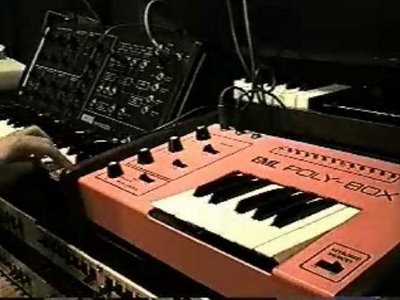 Finally get to see one of these in action. The Poly-Box allows you to play your monosynth polyphonically almost like a real time sampler. It's not clear to me if you can actually play multiple keys at the same time for true polyphony. The video does not show this. If you know please comment.
Finally get to see one of these in action. The Poly-Box allows you to play your monosynth polyphonically almost like a real time sampler. It's not clear to me if you can actually play multiple keys at the same time for true polyphony. The video does not show this. If you know please comment. "Poly-Box is a pitch following variable chord generator controlled by your synthesizer and Poly-Box's own keyboard with built-in memory. Poly-Box takes a single pitch from your synthesizer and creates two banks of pitch sources. Each pitch bank contains 13 simultaneously available pitch sources at precise semitone intervals - covering an entire chromatic octave. The pitch banks may be in the same or different octaves, and can cover the range from one above to three octaves below the synthesizer oscillator."
More on the Poly-Vox on VSE.
Updates:
1. Make sure to check out the comments for more on the Poly-Box
2. David Rogoff sent the following link on the basic technology to AH: http://www.organservice.com/crm/topdividers.htm
3. RSF made a comparable box, the black box (via synth ollie also on AH).
Update via Mike DB on AH:
"Clearly he has the polybox output being "re-filtered".
It's an amazing tool, but descriptions of it are often misleading.
Here's my attempt to clarify what it can and can't do. (originally posted
to the EMLsynth yahoo group):
Basically it is designed to track the pitch of one single voice. Then it
has 12 of it's own voices tuned chromatically apart from each other which
can be played on the 12 keys and will sound and stay relative to the
tracked pitch. The original root pitch is always coming from the low "C"
key on the keyboard. For example, press the "E" key of the Polybox
keyboard and you would hear a voice that is a major 3rd above the tracked
"root" pitch. It will follow that source and stay a major third above
it. You can play "chords" or any combination on the 12 keys or all of
them. It does a couple of other tricks like you can move the whole output
up or down a full octave and there are some phasing effects.
It won't read more than one voice and if you try, it will only
respond with some chaotic squawks. Same goes for noise and other sounds
with no distinct single pitch----of course chaotic squawks have their value
too.
It does not translate envelope or filter from the original voice; the
source timbre and expression is not preserved. The new voices are basically
either on or off as you play the keys and they are pretty much of a
generic sawtooth tone which you can fool with a bit on the Poly's
controls. You could, of course, run the Poly's output thru other effects
and filters and such to further modify it, but that's as much as it does
on it's own."
Korg PS-3100 Video on YouTube
 Remember the Korg PS3100? 48 notes of modular polyphony using divide down circuitry. Title link takes you to a video of the PS-3100 sent my way via Keith Seaman. Thanks Keith!
Remember the Korg PS3100? 48 notes of modular polyphony using divide down circuitry. Title link takes you to a video of the PS-3100 sent my way via Keith Seaman. Thanks Keith!P.S. Note the other synth videos to the right when you get there.
Update: Don't miss Part 2 and the other videos on the right when you get there.
Moog Voyager OS 3.2 Release and New Little Phatty Demos
In via AH
"The latest update to the minimoog Voyager operating system has been released
today. It can be downloaded from the following link:
http://www.moogmusic.com/software/vgr_os_3-2.zip
Release notes are included in the zipfile.
This update was developed in tandem with the latest version of SoundTower's
Voyager editor, also just released.
The new editor can address multiple banks of patches (in a Voyager with
expanded patch memory), organise presets by category, and more.
also, there are new, improved Little Phatty sound samples posted on the Moog
website today, for your listening delectation...
cheers,
Amos"
"The latest update to the minimoog Voyager operating system has been released
today. It can be downloaded from the following link:
http://www.moogmusic.com/software/vgr_os_3-2.zip
Release notes are included in the zipfile.
This update was developed in tandem with the latest version of SoundTower's
Voyager editor, also just released.
The new editor can address multiple banks of patches (in a Voyager with
expanded patch memory), organise presets by category, and more.
also, there are new, improved Little Phatty sound samples posted on the Moog
website today, for your listening delectation...
cheers,
Amos"
Roland JP-8080 Clipping?
Title link takes you to an interesting post by Don Solaris on Harmony Central regarding the Roland JP-8080 and clipping of its 12db filter. MuzikB was able to reproduce the behavior on a JP-8080, and I was able to somewhat reproduce it on a JP-8000. However, when I did, I was able to tame it by lowering the AMP Level on the JP8000, and I did not hear a difference in regards to clipping between the 12db and 24db filters. Also it only happened on one particular patch for me. Overall I do not get any clipping. My first thought was this kind of makes sense, but then I realized how much I had to turn the amp level down for the particular patch. If you have either a JP-8000 or JP-8080, try it yourself. Check out the thread for more detail.

Some of MuzicB's thoughts (read the thread for more):
"I mentioned the AMP level adjustment to Don earlier but also note that the signal is pretty tame with the occasional amplitude increase into clipping across certain frequencies. You can adjust the AMP level but the jumps still occur. The more I think about it, the more I believe that this isn't a bug or a mistake on Roland's part but that it was made to react this way.
I'll mess around some more tomorrow as it's getting late.
Keep up that great blog matrix!"
I especially like that last thought. : ) Thanks MuzicB!
Update via Don Solaris:
"I would like clear out some things. AMP setting has not much with this issue. The AMP level was at standard 64/127 value. The only thing we can do with AMP is introduce more distortion due its own nonlinearity, but that has nothing to do with the filter overload issue i am talking about. If we take a value of 64 as a standard 0dB gain, when we set it to 127 we are pushing Amplifier into its own nonlinear area which introduces new distortions (due to additional positive gain).
It is a normal thing when you reduced AMP that distortion got lower. But this is true just for values above 64 (say, reducing from 127 to 70). Below 64, you can't reduce the distortion. If you don’t believe me, do the following: Reduce AMP level below 50 and increase the main volume. You will hear distortion is still present. Or try another one. Put AMP level to max and Main level to low, play a note, you will hear distortion. Now put AMP level to low and Main level to high value - distortion is still here. (Please use headphones).
I think this should be also stated in Matrixsynth blog (which i enjoy reading) as people might think they can solve this issue by reducing AMP level. Unfortunatley that is just not possible as AMP is located post filter. And we should not confuse AMP's own distortion (due to its own nonlinearity), with this filter overload issue.
Keep up the good work Matrix, and thanks for putting this on synthblog."
No problem. Thanks Don.

Some of MuzicB's thoughts (read the thread for more):
"I mentioned the AMP level adjustment to Don earlier but also note that the signal is pretty tame with the occasional amplitude increase into clipping across certain frequencies. You can adjust the AMP level but the jumps still occur. The more I think about it, the more I believe that this isn't a bug or a mistake on Roland's part but that it was made to react this way.
I'll mess around some more tomorrow as it's getting late.
Keep up that great blog matrix!"
I especially like that last thought. : ) Thanks MuzicB!
Update via Don Solaris:
"I would like clear out some things. AMP setting has not much with this issue. The AMP level was at standard 64/127 value. The only thing we can do with AMP is introduce more distortion due its own nonlinearity, but that has nothing to do with the filter overload issue i am talking about. If we take a value of 64 as a standard 0dB gain, when we set it to 127 we are pushing Amplifier into its own nonlinear area which introduces new distortions (due to additional positive gain).
It is a normal thing when you reduced AMP that distortion got lower. But this is true just for values above 64 (say, reducing from 127 to 70). Below 64, you can't reduce the distortion. If you don’t believe me, do the following: Reduce AMP level below 50 and increase the main volume. You will hear distortion is still present. Or try another one. Put AMP level to max and Main level to low, play a note, you will hear distortion. Now put AMP level to low and Main level to high value - distortion is still here. (Please use headphones).
I think this should be also stated in Matrixsynth blog (which i enjoy reading) as people might think they can solve this issue by reducing AMP level. Unfortunatley that is just not possible as AMP is located post filter. And we should not confuse AMP's own distortion (due to its own nonlinearity), with this filter overload issue.
Keep up the good work Matrix, and thanks for putting this on synthblog."
No problem. Thanks Don.
When Robots Compose
Asperges Me
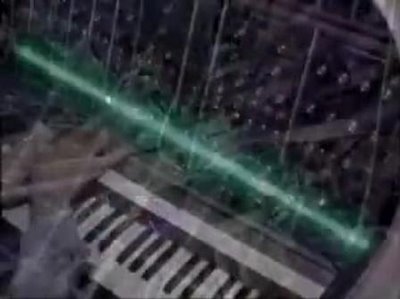 Ran into this one checking out this post on Music Thing. Title link takes you to there. Be sure to check out the other videos on the right when you get there for some Fairlight and Mellotron videos.
Ran into this one checking out this post on Music Thing. Title link takes you to there. Be sure to check out the other videos on the right when you get there for some Fairlight and Mellotron videos.
Waldorf Wave For Sale
Don't see these up for sale often. $7k US gets you the mother of all wavetable synths.

Title takes you to the auction while it's up. PS. I have no affiliation with this.
Details from auction:
"Finally! Waldorf Wave for sale - Excellent condition/mint. New display and newly gone through service. 16 voice polyphony. Ace of Bace Jonas Berggren "Buddha" first owner, bought new by him. After this only one second owner. Serial #: 94 04 00 00 24 Contact Studio Lärje/Gothenburg for more information. "

Title takes you to the auction while it's up. PS. I have no affiliation with this.
Details from auction:
"Finally! Waldorf Wave for sale - Excellent condition/mint. New display and newly gone through service. 16 voice polyphony. Ace of Bace Jonas Berggren "Buddha" first owner, bought new by him. After this only one second owner. Serial #: 94 04 00 00 24 Contact Studio Lärje/Gothenburg for more information. "
Peter Kirn's Real World Digital Audio
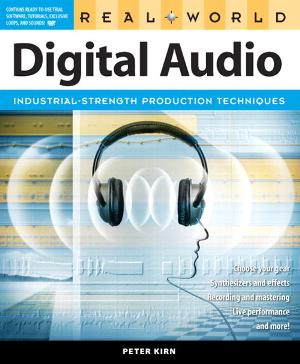 I finally got around to spending some quality time with Peter Kirn’s Real World Digital Audio, and I must say it's solid. You might recognize his name; Peter runs the Create Digital Music blog. This is a great book for both people new to the subjects covered, and those experienced. Flip through the book, pick a chapter that interests you and dig in, or read it from front to back. As an aside, I find that I spend most of my time behind a monitor. Being able to take some time off and kick back with a paperback filled with all of this information was refreshing. Note this is a long post; I wanted to touch on each chapter so you'd have a good idea on what's covered. Don't miss the QA at the end for why Peter wrote this book and what he hopes people to get out of it.
I finally got around to spending some quality time with Peter Kirn’s Real World Digital Audio, and I must say it's solid. You might recognize his name; Peter runs the Create Digital Music blog. This is a great book for both people new to the subjects covered, and those experienced. Flip through the book, pick a chapter that interests you and dig in, or read it from front to back. As an aside, I find that I spend most of my time behind a monitor. Being able to take some time off and kick back with a paperback filled with all of this information was refreshing. Note this is a long post; I wanted to touch on each chapter so you'd have a good idea on what's covered. Don't miss the QA at the end for why Peter wrote this book and what he hopes people to get out of it. So, what is the book about and what can you expect from it? Simply put it's a book about audio production and how to set up a home studio in the most practical sense. What's cool about it and what makes it stand out from other tutorials is that it goes into some depth on how things work - the theory behind how and why you apply certain techniques. BTW, it's filled with tips, links to other resources, tutorials and more. It's written and designed to help de-mystify technique and process. The book actually starts with an excellent chapter on sound theory. It is well written, easy to follow, rich in content, and it provides links to more extensive documentation if you want it.
References to more in-depth information are actually one of two recurring themes in the book that I really appreciated. The other is solid examples and walk-throughs that you can do yourself. Peter solidly lays the foundation for each topic and then provides tutorials and links to more when appropriate. Note that the book is standard college book size and roughly 615 pages long. I found that the level of depth for each topic was nearly perfect in most cases. BTW, the book would make an excellent college course and is meant to be a self study and handbook. It has solid and practical content that you can actually use and build a foundation on. If I had a friend who wanted to get into music production, I'd buy her this book, and I'm sure that after reading it she'd probably be teaching me a few things. : )
So, will a lot of the material be redundant to what you already know? Maybe. Everyone has their own level of experience in audio. You will probably find that you have some chapters covered and others not. Some of this will be familiar to you, but think of it as a good way to reinforce your ego. ; ) To be honest I actually did find little nuggets of information that I did not know in areas I considered myself to be well versed, and sometimes these little nuggets are worth more than a whole chapter. I also found that some of the topics that I didn't expect to be interested in at all were completely fascinating to me (Mics for example in Chapter 6 Recording Instruments and Sound).
The following are the chapters in the book.
Chapter 1: Understanding Digital Sound
This was my kind of chapter. Simply put it covers how sound works. The physical waves and characteristics of sound, how we perceive it and how it is handled in digital form. If you want to know more about bit rates, phase cancellation, signal-to-noise, partials, etc, this chapter covers it.
Chapter 2: Choosing Your Tools
This chapter focuses on the basics behind setting up your hardware and software focused on audio workstation recording (instruments and effects are covered in later chapters). Things like inputs and outputs, choosing the right computer, and music and sound production tools are covered.
Chapter 3: Setting Up Your Equipment
This chapter focuses on how to set up your physical studio such as considering ergonomics, sound isolation, speaker placement, connector types, voltage levels, noise and hum, etc.. Some really good bits in this chapter.
Chapter 4: Preparing Your Computer for Audio
This chapter focuses on setting up your virtual studio. It includes tips on installing and setting up audio hardware and software, optimizing your system and getting the latest driver updates.
Chapter 5: Quick Songs with Patterns and Loops
This is a fun interactive chapter where Peter walks you through setting up loops with either GarageBand on Mac or Kinetic on PC (demo versions of both are included in the CD that comes with the book).
Chapter 6: Recording Instruments and Sound
This chapter is broken up between the characteristics of different mics, placement and positioning of mics for different recording techniques, and digital recording in general including setting levels, monitoring and different recording methods. Again, this chapter surprised me in that I thought I would have little interest in mics in general. It was a fascinating read for me being new to the subject
Chapter 7: Processing and Effects
This chapter covers everything you want to know about effects. What's awesome about Peter's book is that he goes into how and why things work. The chapter covers the Basics of Signal Processors, Equalization, Dynamics Processors (compressor, limiter, expander, etc..), Time-Related Effects (delay/echo, reverb), and Specialized Processors (distortion, modulation, pitch correction, etc).
Chapter 8 MIDI: Notes, Rhythms, and Physical Control
This chapter is cool. It covers the basics like connecting your MIDI devices and it covers things like recording and editing your MIDI performances, but it also includes things like the Anatomy of a MIDI Message. Again this is not a technical book on audio so you won't get a in depth MIDI manual here, but what you do get is good solid overview of how MIDI works beyond just hooking up a controller and banding on some notes.
Chapter 9: Synthesis and Software Instruments
Ok, I admit this along with Chapter 4 are my areas of expertise, so... It was awesome! I approve. : ) The chapter starts with an overview of synthesis including different types of synthesis and.... It encourages you to make your synth you! It encourages the reader to program their own sounds. The chapter covers sampling, the building blocks of synthesis including oscillators, envelopes, filters, modulation, etc. Way to go Peter! I love that anyone that might go through this book not being familiar with synthesis, will now have a tutorial like this. Too cool. NOTE: this along with much of the rest of the book could easily have just been a quick "10 step" guide to hooking up your studio. What's awesome about this book is that it presents how to do things with why behind it. It appreciates the theory and reasoning that goes into setting up a good studio.
Chapter 10: Put It Together: Arrange, Mix, and Master
This chapter covers Arranging, Mixing, Mastering and Sharing your work. This chapter is the meat and potatoes section of laying and mixing tracks. Things like arrangement view and timeline, slices and beats, spatialization, dithering and export quality are just a few of the things covered in this chapter.
Chapter 11: Producing Printed Scores
This chapter focuses on notation software. This is the meat and potatoes chapter on writing and editing notation.
Chapter 12: Music and Sound for Video
This chapter covers synchronization (matching sound and image), timing and notation, performing with live musicians, postproduction and more.
Chapter 13: Playing Live
This chapter covers how to play soft synths live, using audio inputs and effects with real time control, live sampling, djing with a computer, and more.
So do I recommend this book at the asking price? Yep. It's worth it. I would take a look at the chapters above and ask yourself if one, could you use it, and two are there topics you would enjoy reading on a lazy afternoon? If the answer is yes to either of these, get it.
This is a great book Peter, congratulations on this acheivement!
1) Why did you write the book?
"I really felt that a general reference on making music with computers,
written in a way that beginners could approach but that was also
thorough and up-to-date, was missing. What the average musician does
with computers has expanded so much. It's not just recording, it's not
just mixing. It's also playing soft synths and designing sounds and
composing and arranging and scoring and so on. I wanted to see a
big-picture book that put practical information on all these topics in
one place, without being overwhelming.
It happened that I talked to Chris Breen at Macworld about this, and
learned Peachpit was looking for just such a book. I didn't originally
intend for me to be the author, to be truthful, but that's how things
often happen.
After you finish a book you hopefully have more perspective on the
process than while you're in the middle of it, or at least that was
the case for me. For me this was a way of condensing a lot of
knowledge out there into a central location, not only my own knowledge
but what I've learned from all sorts of great teachers. I've been
reading a lot of other books lately -- non-music books, as I've been
programming visual work in 3D environments -- and it's great to have
that experience with other people's writing. Even as a web-based
writer, I'm totally dependent on paper, and on the unique ways you can
express information in book form."
2) What do you hope people will gain from the book?
"I really wanted to convey the fundamentals of music production
techniques, beyond the specifics of certain applications. You'll see
plenty of illustrations, but for me what lets you sit down and make
music is feeling comfortable with the language and the interfaces you
see. I certainly love getting a new synth and playing with mysterious
knobs and such, but you also want to be able accomplish what you're
trying to do, to focus on sound and what you imagine, and to deal with
all the technical issues that could otherwise slow you down.
And it's certainly not an endpoint -- hopefully a book gets you
started on topics, and makes you want to read and learn more. I think
I'll have to start a running web bibliography for RWDA, because people
are already asking "where do I go next?" which is fantastic."
3) How do you recommend people read the book?
"This is entirely dependent on where you are, because we worked really
hard on making it compatible with a broad audience.
It should be completely possible to start on page 1 and read to the
end. We talked a lot about how to go from one element to another, to
make it readable. I also tried to design the hands-on examples so that
you could work through chapters -- particularly after the first third
of the book, once you get into more practical stuff -- and try things
out. There's the demo software on the DVD for that purpose, some of
which, happily, you can use indefinitely. (Even the Ableton Live demo
is pretty functional without purchasing it.) That's important, because
if you haven't yet chosen your software tools, you can try this stuff
out and get a taste, and make a more informed decision about which way
you want to go. But if you do have software tools of choice, I tried
to be careful about covering ideas that apply from one program to
another. I often wrote chapters with Cubase, Pro Tools, Logic, Digital
Performer, SONAR, and Live all running, looking from one to another.
So, that's the linear approach. But it's also designed as a reference
book. For people who are more experienced, I expect they're more
likely to use it that way, either to brush up on a topic by picking up
a chapter or just to refer to it occasionally. Something very fun has
happened for me, which is I can now pick it up as a reference."
PREVIOUS PAGE
NEXT PAGE
HOME













© Matrixsynth - All posts are presented here for informative, historical and educative purposes as applicable within fair use.
MATRIXSYNTH is supported by affiliate links that use cookies to track clickthroughs and sales. See the privacy policy for details.
MATRIXSYNTH - EVERYTHING SYNTH













© Matrixsynth - All posts are presented here for informative, historical and educative purposes as applicable within fair use.
MATRIXSYNTH is supported by affiliate links that use cookies to track clickthroughs and sales. See the privacy policy for details.
MATRIXSYNTH - EVERYTHING SYNTH

